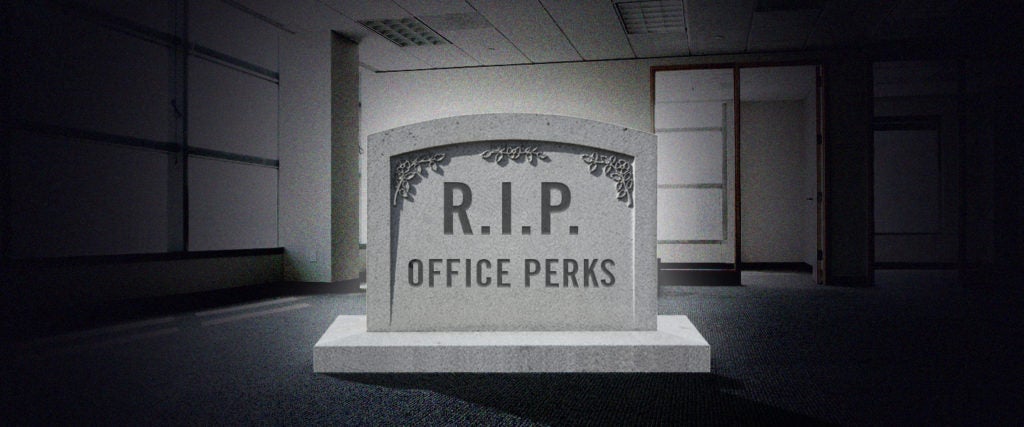In May, not even two months after their employees had transitioned to working from home, Google announced that their workers were no longer allowed to expense food or gym costs. “The clarification comes as some employees, who enjoyed a plethora of perks as one of their draws to the company, hoped they would be able to maintain some of these perks after they were ordered to work from home due to the COVID-19 pandemic,” per a CNBC report from May. The policy update all but confirmed what most tech-company workers have known for years: The in-office perk was never really a function of corporate benevolence.
In 2014, the New York Times reported much the same sentiment, noting that, by and large, the in-office perk was a function of an “arms race” between tech companies competing for the best and brightest talent. Things like free lunches, coffee and being able to bring your pet to work were designed to keep people at their desk for longer periods of time. “They’re golden handcuffs,” Gerald Ledford, a senior research scientist at the Center for Effective Organizations at the University of Southern California’s Marshall School of Business, told the paper.
Naturally, most tech company workers caught on. “My sense is that the office perks aren’t the main thing driving someone to take a job, but are useful justifications for themselves supporting their decision to work somewhere,” says Dave Mayer, professor in the management and organizations area at the Ross School of Business at the University Michigan.
Indeed, according to Glassdoor’s 2015 Employment Confidence Survey, while 60 percent of people report that benefits and perks are a major factor when appraising job offers, the “in-office perk” — free lunches, in-office baristas, yoga studios and the like — came seventh on the list of the most important benefits. Instead, most employees were after things like health insurance, paid time off, retirement plans and performance bonuses. “Tuition reimbursement, professional development opportunities, diversity programs and childcare support also made the list, indicating that employees take a pragmatic outlook to their careers,” Dan Ruch reported for Entrepreneur in 2017. Basically, the sort of things that actually bring about a positive impact on a person’s livelihood.
Nonetheless, most tech company employees will gladly concede that the in-office perk is not nothing — getting free lunches or pilfering snacks for your own kitchen cabinet is obviously a gigantic privilege, when considering the number of people who can’t even rely on stable employment hours. And while Google has eliminated the “free lunch” perk for their employees, all of whom are now working from home, Mayer tells me he doesn’t think the “in-office perk” is gone for good. “Providing gym memberships, healthy meal plans delivered to your house and company-sponsored virtual mental health assistance will likely be in the mix,” he says.
In addition, Mayer says that the re-envisioned perks could extend toward helping people socially (i.e., paying for dating app memberships) given the social connection that will be lost in the office. To that end, according to a recent report in Fortune, “Some in the industry say that there was already a slow shift away from in-office perks and toward other types of benefits — the kind that are also attractive to those who work remotely or whose lifestyles don’t enable them to stay in the office until 10 p.m.”
According to the same report, “Slack is already offering childcare credits to employees with young children and offering caregivers unlimited days off.” (Of course, anyone who’s ever worked under the “unlimited vacation” policy knows that it usually means people are less likely to use their vacation days.)
Still, there’s no doubt that at a time when employee burnout is at an all-time high — career platform Monster found in a July survey that 69 percent of remote employees have burnout symptoms — there needs to be greater focus on the part of employers to figure out ways to help their workers stay healthy and sane.
The answer, at least based on a recent study from consulting firm Gallagher, is that in this new work-from-home era, employees more than anything else want “flexible working hours, flexible annual leave and flexible salary payments,” per a report in the Financial Review. Mayer agrees, telling me that “perks that allow for more work-life balance are increasingly making their way up the priority list of younger employees.”
All of which is to say that the COVID era has at least magnified the duplicitous nature of the in-office perk. With the future of the office itself in question as this pandemic continues to drag on with no end in sight, it’s clearly going to take a lot more than a hip bean bag and a coffee bar to ease the pressures of work.

